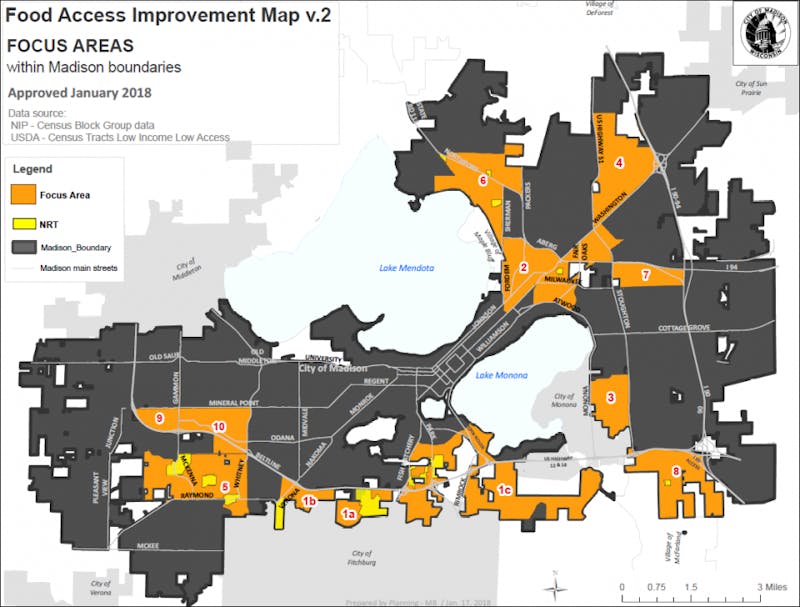
Focus areas for food access improvement in Madison as of 2018.
Image By: City of Madison
Focus areas for food access improvement in Madison as of 2018.
Image By: City of MadisonFood is something some of us take for granted. While most Americans have access to food, not all have access to healthy food and reliable sources to obtain it. Communities without accessible grocery stores are known as food deserts. Even agriculturally rich areas like Wisconsin have food deserts — which are a primary cause of food insecurity. Contrary to popular belief food deserts are quite prevalent in both urban and rural areas. In fact, being on UW’s campus likely puts you in a food desert. While you may be surrounded by dozens of cafes and restaurants, there are not many options within walking distance for affordable, healthy food for students and others living in the downtown area.
Food deserts pose a serious issue, especially for communities of color which report far less access to grocery stores. On top of this, fast food joints are five times more common in minority communities than predominantly white ones. With limited access to fresh produce and quality foods, it takes a great deal of effort to achieve a nutritionally adequate diet in a food desert. It does not take a genius to connect the dots to realize that this leads to disproportionate obesity and negative health outcomes in non-white populations, which are often located near food deserts.
Addressing the food desert problem requires intervention to prevent the cyclical nature of supply and demand. Food deserts are mostly in low income areas, which are on average less educated than middle and upper income areas. Residents of these areas are not only isolated from quality food, but from nutritional education. As a result, they purchase processed foods from convenience stores or fast food restaurants that are easily accessible, which exacerbates the problem by creating more demand for less healthy products. Without interference, the cycle continues, damning poor populations to more chronic diseases and earlier deaths.
Another key to removing the barrier to healthy food is education. While nutrition education is widespread in schools, it is focused primarily towards middle school children. Students are taught topics such as the food pyramid and dietary goals, which prove insufficient to meaningfully address the situations of many students.
As it turns out, offering nutrition courses is far different from requiring them. Less than half of high school students are required to take nutrition courses, despite the importance of nutrition education across one’s lifespan. The depth of the material taught is also questioned, with the food pyramid being the only nutritional topic that is thoroughly discussed in more than half of schools, and the majority of nutrition related topics are covered in around 25 percent of districts. Part of this problem can be attributed to the fact that most nutrition information is taught at the teacher’s discretion, with 61 percent of schools having no oversight for their nutrition education programs.
Even if nutrition programs are included, there are obstacles that could get in the way of healthy diets. Primarily, food options at home are likely quite different than those at school, which creates a challenge for students who may be learning about nutrition in school, but not being able to put that information into action at home. If this disconnect continues, it is not likely that education will “stick” with the child and positively impact future food choices.
All of these problems loop back to food deserts, which drastically limit the availability of healthy foods. The difficulty in addressing these problems centers around improving access to affordable nutrition that is appealing to people of different cultures and budgets.
Recent efforts to fix disproportionate access to healthy foods have succeeded by erecting grocery chains in low-income communities, and, perhaps more importantly, connecting communities to their food supply. Establishing farmer’s markets, urban agriculture and affordable grocery delivery services are just a few of the solutions currently being used to get healthy food to consumers.
What health professionals must do now is find a way to make nutrition appealing and available to people of all backgrounds and socioeconomic statuses. While the fight against food deserts and insecurity are of the utmost importance, they are only the beginning of improving public health. Changes to nutrition education and attitudes towards food are vital components in removing the focus from bad diets and expensive health trends towards sustainable eating changes that are wallet and palate friendly.